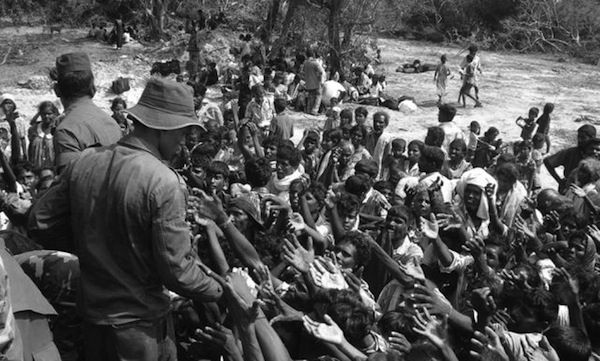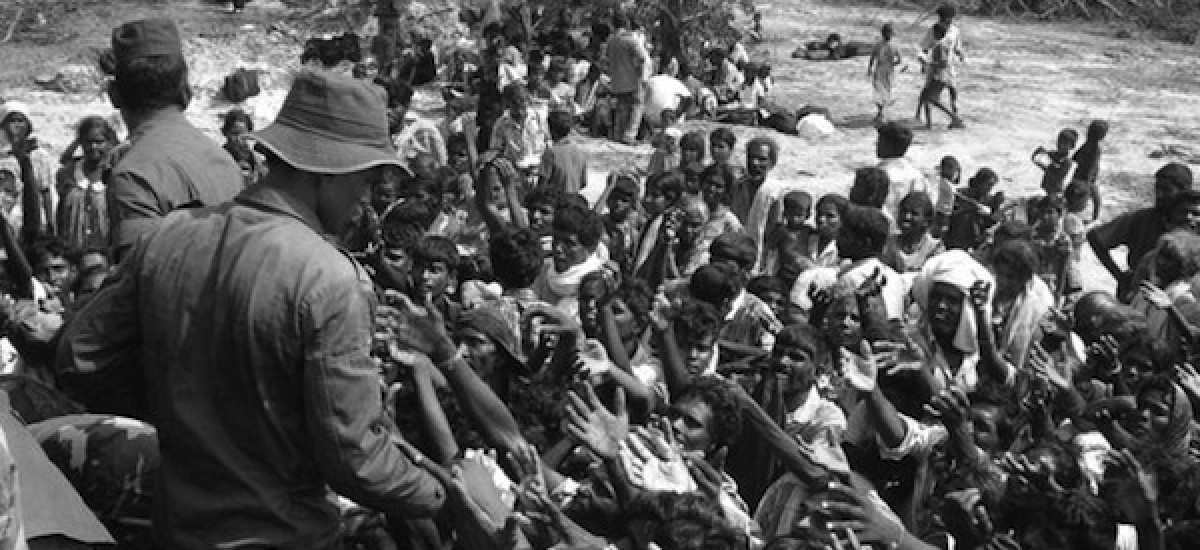
Image courtesy Hill Post
Kath Noble recently published two articles in The Island, which were reproduced on Colombo Telegraph. [i]
Bring on the Usual Suspects
Some of the reactions to what Ms Noble wrote were depressing but, sadly, not surprising. The usual suspects came up with the usual polemic. Says Dev: “This is absolute rubbish – mere speculations and prejudices! This is a shame on journalism sans facts.”
Many comments on such threads display a similar cognitive dissonance. Commenters seem unable to distinguish between reporting and advocacy, between explanation and justification. Some assume that a view quoted by the writer is the view held by the writer.
Dev calls for facts. It depends what you mean by facts. Colombo Telegraph’s motto is “In Journalism truth is a process”. Dev seems only interested in facts that fit his predisposition but accuses Ms Noble herself of “mere speculations and prejudices”.
He does not seem to have grasped that Ms Noble is reviewing a publication[ii] written by someone else. That publication itself surveys various “facts” put forward about the numbers of civilians killed in the final months of Eelam War IV.
When I wrote about the Marga Institute seminar on The Numbers Game, another commenter displayed an ambivalent attitude to facts: “Numbers don’t matter, it is the truth that matters”.
Higher and Lower
Those who accuse the IDAG-S report of whitewashing GOSL bizarrely overlook the inconvenient fact that the estimate that the report eventually settles on is actually HIGHER than some of the estimates put forward by Tamils, even LTTE sympathisers.
Unlike Ms Noble, I am not an Oxford graduate in mathematics. I struggled to pass O-level maths, scraping through at the third attempt. Although Ms Noble cites IDAG-S’s figure as 15,000 dead, the way I read the report, IDAG-S say the number of deaths could have been 18,000. That is not insignificant. I acknowledge that even the lowest figures I represent a lot of human pain and bereavement. I would never say “only 18,000 civilians were killed”.
Compare this with lower estimates by Tamils:
- Navi Pillai’s press release saying “as many as 2,800″ could have been killed.
- Data compiled by the South Asia Terrorism Portal, data “primarily based on figures released by the pro-LTTE Website Tamil Net”, put the casualty figure for civilians inside Mullaithivu at 2,972 until 5 April 2009.
- Rajasingham Narendran said: “My estimate is that the deaths — cadres, forced labour and civilians — were very likely around 10,000 and did not exceed 15,000 at most”
- Muttukrishna Sarvananthan of the Point Pedro Institute estimated “[approximately] 12,000 [without counting armed Tiger personnel] “.
- Dr. Noel Nadesan: “roughly 16,000 including LTTE, natural, and civilians”. [iii]
Whitewash by IDAG-S?
Usha S Sri Skanda-Rajah wrote: “I know where these apologists for Sri Lanka are heading – to exonerate Sri Lanka, demonize the rebels and declare any civilian deaths were due to the rebels and collateral damage – Nice try!”[iv]
There are some words in the IDAG-S report which do not sound like the words of government apologists. This is what the authors of the IDAG-s actually say:
“The respective proportions of civilians killed by the LTTE and the government forces is difficult to work out. Though it is probable that more were hit by government forces than by the LTTE, the latter’s ‘work’ in this sphere was not small”.
“Nothing in this survey denies the probability and the evidence that some extra-judicial killings of high-ranking LTTE officers occurred during the last days of the war. These actions need to be impartially investigated by an independent body, and where possible criminal indictments pursued against the perpetrators.”
No Good Deed
It was saddening but not surprising to read some of the comments about the Marga seminar. There was the usual Pavlovian reaction. According to some commenters, the whole event was just an excuse to whitewash the government. This view ignored the fact that people (such as Jehan Perera and Pradeep Jeganathan) who are not normally seen as government stooges attended. A subsequent meeting was attended by the Canadian High Commissioner. Jeevan Thiagarajah attended a third meeting.
What Dr Godfrey Gunatilleke actually said at the first seminar was that it was important that we address the moral responsibility and accountability of all actors in the conflict. He acknowledged that, while even a low number of civilian casualties was cause for anguish, citing large and inaccurate figures could only inhibit the healing process. Many who spoke at the seminar said that there is a strong case for accountability and recognition of the loss of life but feared that the current situation did not hold out much hope for genuine reconciliation. There was a strong theme at the seminar of the need to acknowledge the size of the catastrophe. It was agreed that victory parades are not a helpful form of commemoration. Remembrance and mourning were advocated. There was a consensus that civil society must engage with the GOSL, focusing on the LLRC recommendations on the process of collective atonement, and that leadership on this needs to be given by the President.
At the conclusion of the seminar, the question was posed: “How can we engage in the international debate and how can civil society encourage the implementation of LLRC recommendations on issues relating to humanitarian law and civilian casualties?”
It was sad that such unexceptionable sentiments should unleash such hatred. [v] Why should a plea for atonement, remembrance, mourning, accountability, reconciliation be met with anger? The Marga Institute itself was smeared, without any substantiating evidence, with being “sleazy” government apologists. Amar Gunatilleke responded: “Let us get on with our work on reconciliation. Let’s help the victims and do whatever we can for them. I am not sure whether we are medically qualified to attend to dementia or any other type of mental illness of others who refuse to move forward. Maybe it is their bitterness that has eaten into them”.
E-Bile
Despite its apparent success in rebuilding the nation after an indubitable genocide, the Rwandan government has been criticized by human rights groups. President Kagame argued that some Westerners define “human rights” too narrowly, defending rights of personal expression but underestimating the importance of stability and economic progress. Rwanda is covered with memorials to the genocide. In spite of this enforced “remembering” there are also “silences”. No history is taught in schools because there is no consensus on what to put in the national curriculum. Rwanda’s current economic success comes at a price: speech about ethnic groups and the government is now extremely restricted. Vicious verbal battles similar to those on Groundviews and Colombo Telegraph between Tamil separatists and Sinhala chauvinists would not be allowed in Rwanda.
Censorship for the maintenance of ethnic harmony is a quagmire. It should not be tried in Sri Lanka whatever happens in Rwanda.
Moderation in All Things
However, most reputable websites have a moderation policy which forbids author abuse, obscene or offensive language and off-topic discussions. Only extreme libertarians would object to a website policing itself to eliminate hate speech that stirs up racial animosities. Whether a comment falls into any of those categories is determined by editorial judgement. Where do you draw the line between moderating and censorship?
The price paid for freedom of speech is that gangs of thugs, whose malevolence towards their fellow human beings is pathological, pseudonymously prowl the precincts of the internet. The people who moderate do not always know the difference and are, allegedly, sometimes part of the gangs. Someone has privately suggested to me that many of the pseudonymous trolls are actually fakes manufactured by the editors to drum up interest. An analysis of the UK Guardian’s on-line community by digital consultant Martin Belam suggests that debate is dominated by a tiny minority. (He estimated that a fifth of comments were left by just 0.0037% of the paper’s declared monthly audience.)
Freedom and Licence
I do not know Kath Noble well, but I would judge from her writing style that her skin must be at least as thick as mine although my head would be the thicker of the two of us. Those of us who spend a lot of time blogging get used to stupid attacks by people hiding behind a pseudonym. Such attacks are more damaging to the forum than to the writer.
One commenter on Ms Noble’s recent article spends a good deal of time discussing figures in a reasonably sensible manner and then loses it: “This is what happens due to inbreeding among you brahmins, some of you become retards. It is high time to diversified your breeding into other castes because the mutations in your DNA must have maximised by now due to the inbreeding, producing dumbasses like you.”
Would anyone behave like this in real life?
Remembering and Forgiving
How do we strike a balance between remembering and the infantile abuse that too depressingly often passes for comment on the websites of newspapers? How do we contrive a discourse that notes the mistakes of the past without allowing the armchair conflict junkies to encourage further mistakes to be made?
It came as no surprise to see the Marga Institute vilified as both pro-government and anti-government. People making such accusations relied on rhetoric rather than sense and did not make any useful contribution. Amar Gunatilleke wrote: “After going through 142 comments I could see only a handful of suggestions regarding the way forward”.[vi]
David Blacker commented about these keyboard warriors: “They are looking for platforms from which to spout rhetoric. When facts and actual invitations to action (such as Amar’s) are put down before them there will be either a deafening silence, or mumbled excuses. These people are charlatans, peddlers of snake oil, living off a diaspora desperate for hope.”
[i] http://www.colombotelegraph.com/index.php/this-is-no-game/, http://www.colombotelegraph.com/index.php/a-genuinely-credible-estimate/comment-page-1/#comment-637601
[ii] http://www.scribd.com/doc/132499266/The-Numbers-Game-Politics-of-Retributive-Justice
[iii] I deal with the figures in more detail here http://pcolman.wordpress.com/2013/05/07/deadly-accountancy-part-2/
[iv] http://groundviews.org/2013/05/28/sri-lankas-numbers-game/
[v] http://www.colombotelegraph.com/index.php/who-speaks-for-sri-lankas-tamils/#comments
[vi] http://groundviews.org/2013/05/28/sri-lankas-numbers-game/

